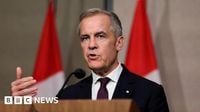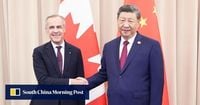On October 31, 2025, a diplomatic milestone unfolded on the sidelines of the Asia-Pacific Economic Cooperation (APEC) summit in Gyeongju, South Korea. Canadian Prime Minister Mark Carney and Chinese President Xi Jinping sat down for the first formal meeting between leaders of their two nations in eight years, a move both sides quickly hailed as a “turning point” after years of frost and friction. The meeting, lasting about 40 minutes, signaled a potential thaw in a relationship that has been battered by trade wars, diplomatic rows, and global power shifts.
"Very pleased with the outcome of the meeting," Carney told reporters, according to National Post. "We now have a turning point in the relationship—a turning point that creates opportunities for Canadian families, for Canadian businesses and Canadian workers." President Xi, for his part, struck an optimistic note at the start of their encounter: "In recent times, after mutual efforts, China-Canada ties have shown a recovery and improvement trend. This aligns with both countries’ mutual interest." Xi added, "China is willing to work with Canada to push China-Canada ties to return to the correct track of being healthy, stable and sustainable as soon as possible."
The symbolism was unmistakable. The two leaders’ meeting was the first since 2017, underscoring just how far the relationship had drifted. In the years since, Canada and China navigated a series of crises that left deep scars. In 2018, Canada arrested Huawei executive Meng Wanzhou on a U.S. extradition request, prompting Beijing to detain two Canadians, Michael Kovrig and Michael Spavor, on espionage charges. All three were released in 2021, but the incident left a legacy of suspicion and anger on both sides. As BBC reported, “Prior to the tariffs, Canada-China relations were already reeling from a diplomatic row that resulted in Beijing detaining two Canadian citizens.”
Trade tensions then escalated dramatically. In 2024, Canada imposed a 100% tariff on Chinese electric vehicles (EVs), followed by a 25% tariff on Chinese steel and aluminum—a move that mirrored increasingly protectionist policies from the United States under President Donald Trump. China retaliated in March 2025 with steep tariffs on Canadian agricultural products, including a 76% levy on canola seed imports and a 100% duty on canola oil, meal, and peas. The consequences were immediate and painful, especially for Canadian farmers in the western provinces, who have long relied on China as their biggest canola customer.
Western provincial leaders, including Manitoba’s Wab Kinew and Saskatchewan’s Scott Moe, have called on Ottawa to reconsider tariffs on Chinese EVs, warning that Canada is now entangled in a “two-front trade war” with its two largest trading partners: the United States and China. The U.S., for its part, has imposed a 35% tariff on Canadian goods not covered by free trade agreements, a 50% tariff on steel and aluminum, and a 25% levy on automobiles. The situation reached a new low last week when President Trump suspended all trade talks with Canada after a spat over an anti-tariff ad campaign aired by Ontario Premier Doug Ford. Trump has even threatened to raise tariffs on Canadian goods by another 10%.
Against this volatile backdrop, the Carney-Xi meeting took on special significance. As Reuters noted, Carney accepted Xi’s invitation to visit China, a gesture that “signalled a ‘turning point’ in the countries’ relationship.” Both leaders directed their officials “to move quickly to resolve outstanding trade issues and irritants,” with a focus on key sectors such as agriculture, agri-food products like canola, seafood, and electric vehicles. The official readout from Carney’s office also mentioned discussions of deeper cooperation in energy, agriculture, manufacturing, climate change, and international finance.
Carney was candid about the challenges ahead. Earlier in the week, he had downplayed expectations for immediate tariff relief, describing the meeting as “the start of a broader discussion.” He acknowledged there were areas where quick progress was possible, such as easing travel restrictions, but emphasized the need to set conditions for longer-term solutions on more sensitive issues. “We’re starting from a very low base and we can move quite substantially before we start to get to sensitive areas,” Carney told reporters, according to National Post.
The economic stakes are high. Carney has made no secret of his ambition to double Canada’s exports to markets outside the U.S. within a decade, aiming to net an extra C$300 billion (about US$215 billion) in trade. With Trump’s tariffs squeezing Canadian industries, especially in energy and manufacturing, Carney has argued that Canada must look eastward and strengthen ties with the “economic giants of Asia.” As he told BBC last week, “Distance is not the way to solve problems, not the way to serve our people.”
The renewed dialogue comes at a time when both Canada and China are feeling the heat from Washington’s aggressive trade policies. Trump’s global tariff onslaught has left both countries scrambling to diversify their trade relationships. Just one day before Carney and Xi met, Trump and Xi themselves agreed to dial back their own trade war, with Trump halving fentanyl-related tariffs on China and Xi pledging to keep rare earths flowing to the U.S. and boost imports of American soybeans. Still, as National Post reported, the average U.S. tariff on Chinese imports remains at a hefty 47%.
Carney, at the APEC gathering, acknowledged the shifting global landscape: “The old world of steady expansion of rules-based liberalized trade and investment, a world on which so much of our nations’ prosperity—very much Canada’s included—[is based], that world is gone.” He also highlighted Canada’s potential as an “energy superpower” and major supplier of liquefied natural gas (LNG) to Asia, a pitch aimed squarely at diversifying away from the U.S. market.
Of course, the road to a full rapprochement will be anything but smooth. Lingering issues around foreign interference—China has been accused of meddling in Canada’s 2019 and 2021 elections, though a Canadian public inquiry found the impact to be “minimal”—and continued restrictions on Canadian beef and pet food exports remain unresolved. And while Xi’s invitation for Carney to visit China is a promising gesture, it will take more than handshakes and photo ops to unwind years of mistrust and protectionism.
Still, for the first time in years, there is a sense of cautious optimism. Both leaders have acknowledged the need for “constructive and pragmatic dialogue,” as Carney put it, and have set their sights on building a “sustainable, inclusive international system.” Whether this new chapter will deliver tangible benefits for Canadian farmers, manufacturers, and families remains to be seen—but the door, at least for now, is open.
With the world order in flux and old alliances under strain, the Carney-Xi summit may mark the beginning of a new, if fragile, era in Canada-China relations—one defined as much by necessity as by hope.






